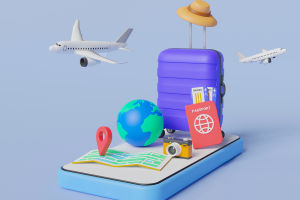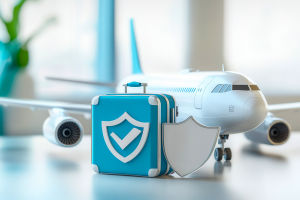Travelers often find themselves caught between two extremes: packing too much and regretting the weight, or packing too light and regretting forgotten items.
Whether you're heading out for a weekend city break or a month-long international adventure, efficient packing is an art that can save you time, money, and stress.
So how do you pack like a pro—light, yet complete?
Let's break it down into practical, everyday steps that will make your next trip smoother from the suitcase up.
1. Start with a Purpose-Based List
Before you unzip that suitcase, take 15 minutes to plan.
Ask yourself: Where are you going? For how long? What's the weather like? What will you do there? Based on this, write a short, functional packing list. Instead of vague items like "clothes" or "toiletries," get specific: "2 lightweight T-shirts, 1 waterproof jacket, sunscreen (100ml tube)."
Digital tools like PackPoint or simple notes apps can help you create repeatable, trip-specific lists. Once you've done this two or three times, it becomes second nature.
2. Follow the Rule of 5, 4, 3, 2, 1
This minimalist strategy helps you stay within limits while ensuring variety. For a week-long trip, try this:
• 5 tops (mix of short and long sleeve)
• 4 bottoms (2 pants, 1 skirt, 1 shorts)
• 3 pairs of shoes (sneakers, sandals, one dressy option)
• 2 jackets or layering pieces
• 1 set of swimwear or special-activity gear
Of course, adjust according to your destination—if you're going hiking in Patagonia, you may trade the dress shoes for thermal layers.
3. Use Packing Cubes for Order and Space
Packing cubes are more than trendy—they actually work. They compress clothing, separate clean from dirty, and save you from the dreaded "where is my charger?" shuffle at the hotel.
Use color-coded cubes for tops, bottoms, underwear, and accessories. Try rolling clothes inside the cubes instead of folding—they wrinkle less and fit more.
4. Know What NOT to Pack
One of the smartest packing habits is learning what you don't need.
Here are 5 commonly overpacked items:
1. Full-size toiletries – Most hotels provide basics. Otherwise, buy mini sizes or refill travel bottles.
2. Towels – Unless camping, leave them behind. Most accommodations provide towels.
3. Extra shoes – Unless you're attending events with dress codes, 2 pairs are usually enough.
4. Books – Use e-readers or apps to avoid heavy baggage.
5. "What if" clothes – If you don't wear it regularly at home, chances are you won't wear it abroad.
5. Weigh and Test Your Bag
Airlines are strict. If you're flying low-cost carriers like Ryanair, Jetstar, or AirAsia, your cabin bag often needs to be under 7 kg. Always weigh your bag after packing.
Next, test it: can you lift it above your head or carry it for 10 minutes without strain? If not, trim it down.
6. Consider Local Services
Heading to a city like Tokyo, Amsterdam, or Seoul? Many hotels and hostels offer laundry services or have washing machines available. Knowing this allows you to pack fewer clothes and reuse outfits.
Pro tip: In European cities like Lisbon or Prague, self-service laundromats typically cost €3–€5 per load and are easy to find using Maps.
7. Travel with Multi-Use Items
Some items work double or triple duty, helping you save both space and weight. Examples:
• A sarong: functions as a scarf, beach towel, blanket, or makeshift curtain.
• Universal travel adapter: one device for all electronics across continents.
• Moisturizing cream: acts as lotion, lip balm, and cuticle care.
• Merino wool T-shirt: naturally odor-resistant and can be worn multiple times.
8. Smart Tech for Smart Travel
Don't let tangled cords slow you down. Use a cable organizer or zip pouch for:
• Charging cables
• Power bank
• Travel SIM or eSIM QR codes
• Backup memory card (especially for photographers)
• Earphones
Apps like TripIt and Maps (offline mode) also reduce the need to carry printed material.
9. Save Room for Souvenirs
Leave at least 10–15% of your bag empty. You'll likely pick up local items like handmade textiles in Oaxaca, olive oil in Greece, or ceramics in Vietnam.
If you're shopping in places like Istanbul's Grand Bazaar or Morocco's medinas, a foldable tote or expandable duffel comes in handy for unexpected buys.
10. Bonus: Carry-On Essentials
Regardless of whether you're checking in luggage or not, always keep these in your carry-on:
1. Passport, tickets, and important documents
2. Medications and prescription copies
3. A change of clothes
4. Reusable water bottle (empty at security)
5. Snacks like nuts or granola sticks
6. Headphones and offline entertainment
These help you stay comfortable in case of delays, layovers, or lost baggage.
Ready to pack lighter and smarter?
Packing isn't about fitting everything you own—it's about choosing the right things for your experience. By planning with intention, using the right tools, and cutting the clutter, you'll not only move easier but also travel better.
So, what's your biggest packing struggle? Forgotten chargers? Too many shoes? Or always over the weight limit? Let's talk about it—and next time, maybe you'll be the one giving packing tips on the road.


